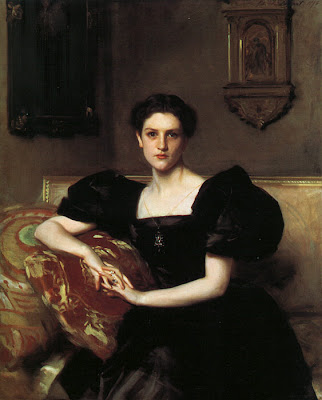As promised, I will be showing you how I painted the skin for this girl, below.
 First, though I want you to look at this painting by John Singer Sargent. Look at her skin. What colors do you see? Orange? Tan?
First, though I want you to look at this painting by John Singer Sargent. Look at her skin. What colors do you see? Orange? Tan?

 Now look at this one:
Now look at this one:


And, now what colors do you see, here:

 It took me a few years of examining his paintings, but I finally saw a trick that he used AND it changed my art forever. Here it is:
It took me a few years of examining his paintings, but I finally saw a trick that he used AND it changed my art forever. Here it is:Grass is green, and so is skin.
"Wait! What? Skin is not green," yes--I can hear you say it. And your right, it is also blue, and purple, cad yellow ... The sooner you learn not to make skin tan and pink the better off as an artist you will be.
You see, Sargent painted the skin dead. Look how yellow it is, how green! But the reason these women look so alive is because he put a mixture of alizarin, cad red, and raw sienna where it counted the most. Look how red the eyes are, the nose, ears, the lips; do you see how pale those hands are until he reaches the tips. He gave the illusion of blood flowing. Next time you look in the mirror examine your features, you will notice the same thing.
I use a mixture of sap green, cad yellow, and raw sienna...cobalt blue and a purple called "purple lake"...

Adding the "red mixture", color to hair
 Finishing touches...
Finishing touches...
Next week:
I will teach you how to know what colors to put where on the face; color change has to do with how the blood flows through the body and the thickness of skin and fat. (Just a fare warning. It will be a little late since I will be out of town visiting my grandma in Reno with no internet.)
that's all well and good if you can see color, but if you're color blind like me, you have to stay away from greens in skin tones, otherwise people think you're painting martians.
ReplyDeletehaha! I guess that is true. What is your trick to painting skin?
ReplyDeleteseveral years ago morgan weistling (via email) told me about winsor newton's terra rosa (oil paint) as a base flesh tone, then adding a touch of yellow, or cobalt blue, or ultramarine blue, or viridian. it has helped me get cleaner skin tones. they used to get pretty muddy at times, due to using burnt sienna as a base.
ReplyDeleteThanks,I will try that. maybe it will work the same with watercolor?
ReplyDeleteoh, i'm not recommending it for you, karen, as you have full color sight and can see all the subtle differences in tones as you paint. i needed something more formulaic to compensate for my visual insufficiencies.
ReplyDeletep.s. have fun in reno!
ReplyDeleteThanks I will!
ReplyDelete